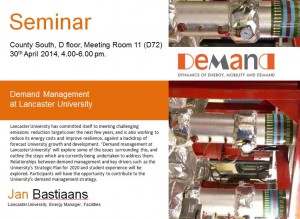 Jan is the relatively newly appointed energy manager at Lancaster University and in his talk he took us through what that job entailed, the carbon and sustainability related targets he is expected to meet and the opportunities and limitations that there are around his role. He stressed the scale and complexity of the campus – over 100 buildings of different ages and construction and a mix of work, domestic and commercial activities within these – and also the overarching University objectives which framed the work he did. The University is seeking to grow, to improve the quality of the student experience and to develop services such as 24hr opening of the library, all of which had implications for energy demand, but were not thought about in those terms. He recognised there was much potential in forms of demand management – including matching demand with onsite wind and solar generation; responding to grid ‘Triad’ notifications; developing more information about and control of energy use across campus – but little capacity at the moment to take these up. Various ideas were discussed that DEMAND could be interested in, including undertaking a ‘flexibility audit’ to identify where demand-response possibilities might be found, a synchronisation analysis of the rhythms of institution and looking at how timetabling could be oriented around demand management opportunities.
Jan is the relatively newly appointed energy manager at Lancaster University and in his talk he took us through what that job entailed, the carbon and sustainability related targets he is expected to meet and the opportunities and limitations that there are around his role. He stressed the scale and complexity of the campus – over 100 buildings of different ages and construction and a mix of work, domestic and commercial activities within these – and also the overarching University objectives which framed the work he did. The University is seeking to grow, to improve the quality of the student experience and to develop services such as 24hr opening of the library, all of which had implications for energy demand, but were not thought about in those terms. He recognised there was much potential in forms of demand management – including matching demand with onsite wind and solar generation; responding to grid ‘Triad’ notifications; developing more information about and control of energy use across campus – but little capacity at the moment to take these up. Various ideas were discussed that DEMAND could be interested in, including undertaking a ‘flexibility audit’ to identify where demand-response possibilities might be found, a synchronisation analysis of the rhythms of institution and looking at how timetabling could be oriented around demand management opportunities.
Understanding Demand
Influencing Demand
Policies for steering demand
Invisible energy policy
Adapting social practices
Commission on Travel Demand
How Demand Varies
Situations, Sites, Sectors
Domestic IT use
Home heating
Offices and office work
Business travel
Online shopping
Car dependence
Older people and mobile lives
Local smart grids
Cooking and cooling in Asia
Energy, Justice and Poverty

